Evaluating Health and Wellbeing Programs' Effect on Absenteeism
VerifiedAdded on 2022/08/15
|19
|3601
|12
Report
AI Summary
This report investigates the relationship between workplace health and safety programs and employee absenteeism. It identifies factors contributing to absenteeism, such as chronic diseases, mental health issues, and work-related stress. The research emphasizes the importance of health and wellbeing programs in minimizing absenteeism and improving overall organizational productivity. Stakeholder analysis highlights the varying interests of different stakeholders, from CEOs concerned with profitability to employees focused on fair compensation and work-life balance. The report uses external surveys, internet research, historical data, and internal interviews to gather data. The findings suggest a positive correlation between comprehensive health and wellbeing programs and reduced absenteeism, leading to increased employee motivation and commitment. The report concludes with recommendations for implementing effective health and wellbeing initiatives, including addressing physical and psychological work environments and promoting work-life balance.
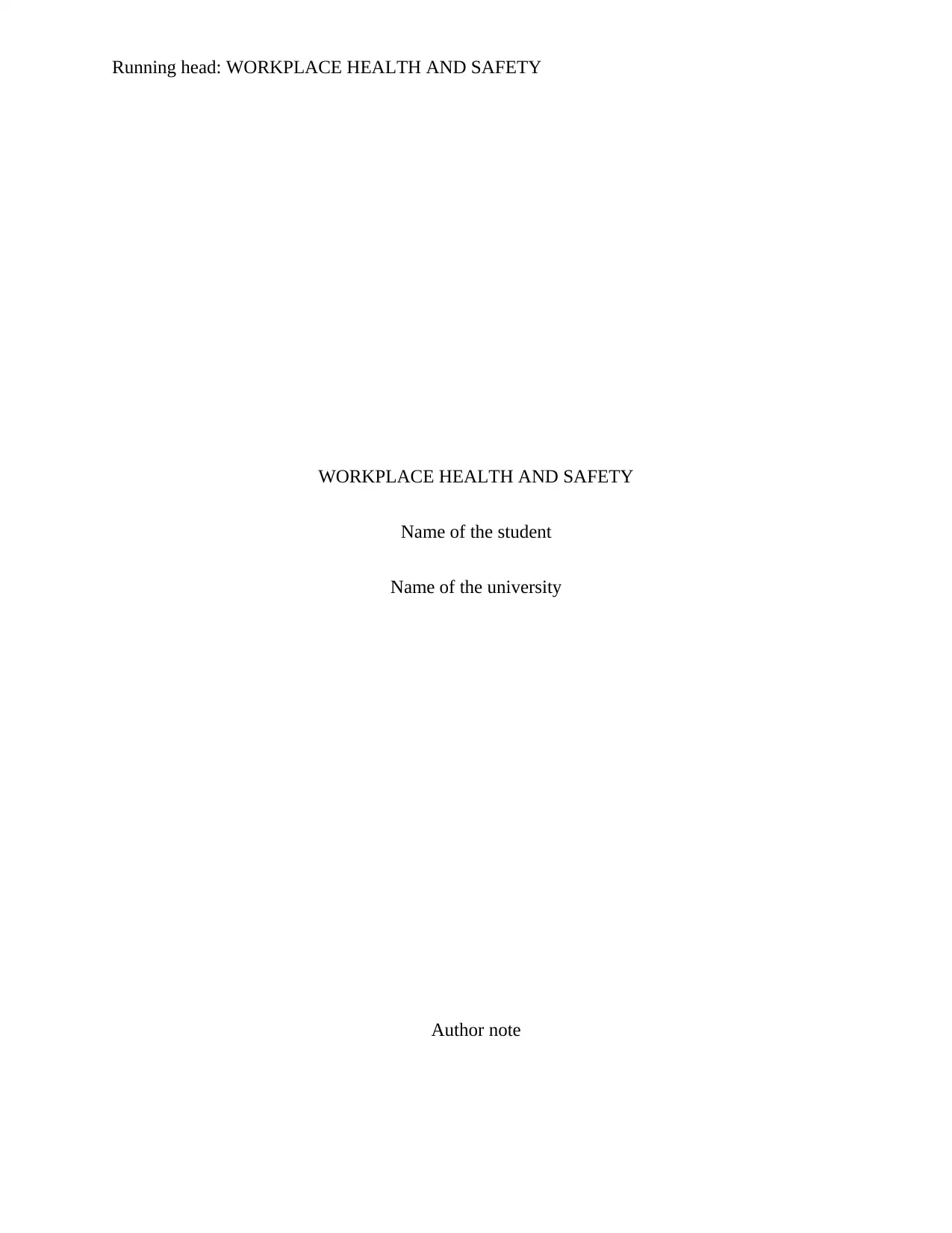
Running head: WORKPLACE HEALTH AND SAFETY
WORKPLACE HEALTH AND SAFETY
Name of the student
Name of the university
Author note
WORKPLACE HEALTH AND SAFETY
Name of the student
Name of the university
Author note
Paraphrase This Document
Need a fresh take? Get an instant paraphrase of this document with our AI Paraphraser
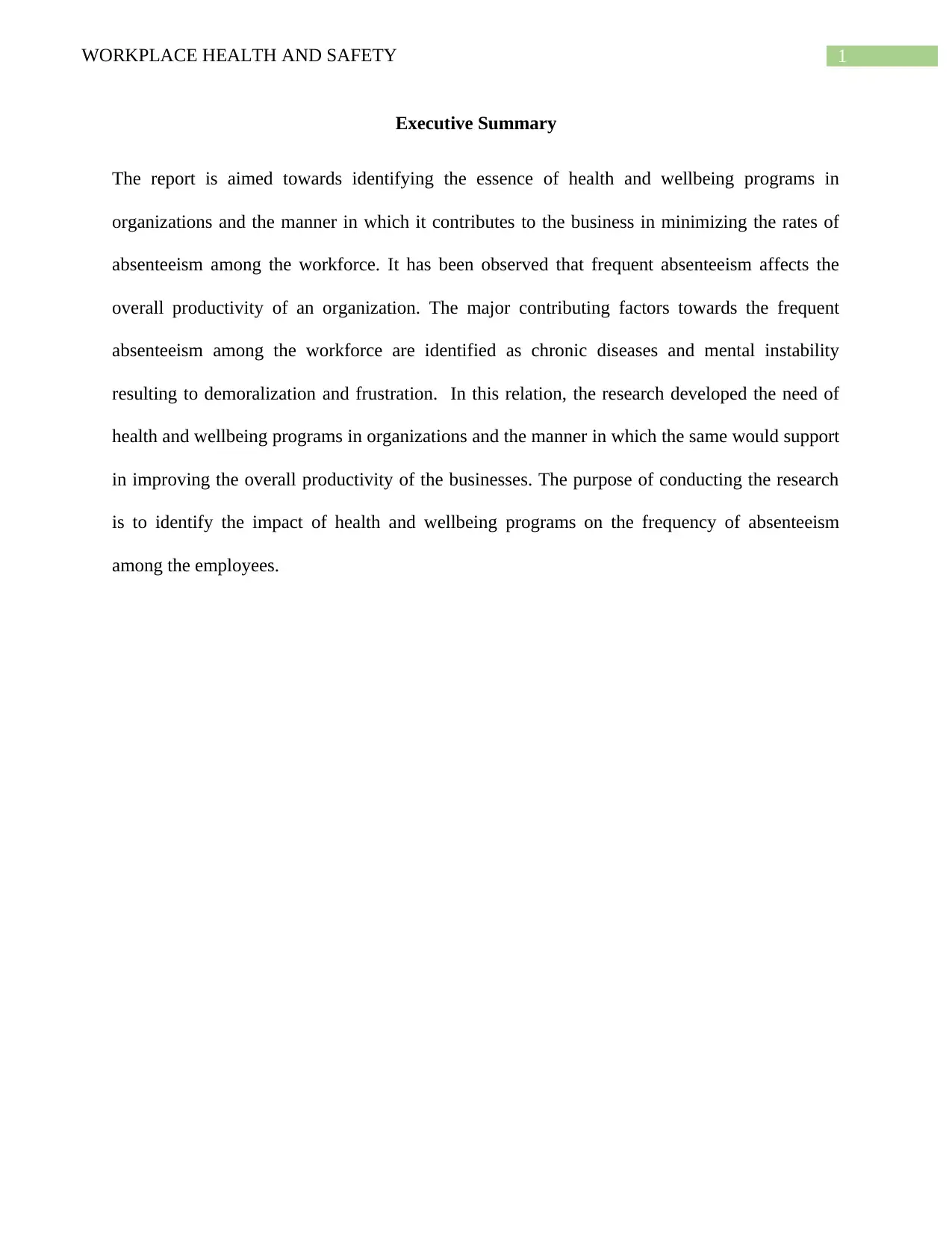
1WORKPLACE HEALTH AND SAFETY
Executive Summary
The report is aimed towards identifying the essence of health and wellbeing programs in
organizations and the manner in which it contributes to the business in minimizing the rates of
absenteeism among the workforce. It has been observed that frequent absenteeism affects the
overall productivity of an organization. The major contributing factors towards the frequent
absenteeism among the workforce are identified as chronic diseases and mental instability
resulting to demoralization and frustration. In this relation, the research developed the need of
health and wellbeing programs in organizations and the manner in which the same would support
in improving the overall productivity of the businesses. The purpose of conducting the research
is to identify the impact of health and wellbeing programs on the frequency of absenteeism
among the employees.
Executive Summary
The report is aimed towards identifying the essence of health and wellbeing programs in
organizations and the manner in which it contributes to the business in minimizing the rates of
absenteeism among the workforce. It has been observed that frequent absenteeism affects the
overall productivity of an organization. The major contributing factors towards the frequent
absenteeism among the workforce are identified as chronic diseases and mental instability
resulting to demoralization and frustration. In this relation, the research developed the need of
health and wellbeing programs in organizations and the manner in which the same would support
in improving the overall productivity of the businesses. The purpose of conducting the research
is to identify the impact of health and wellbeing programs on the frequency of absenteeism
among the employees.
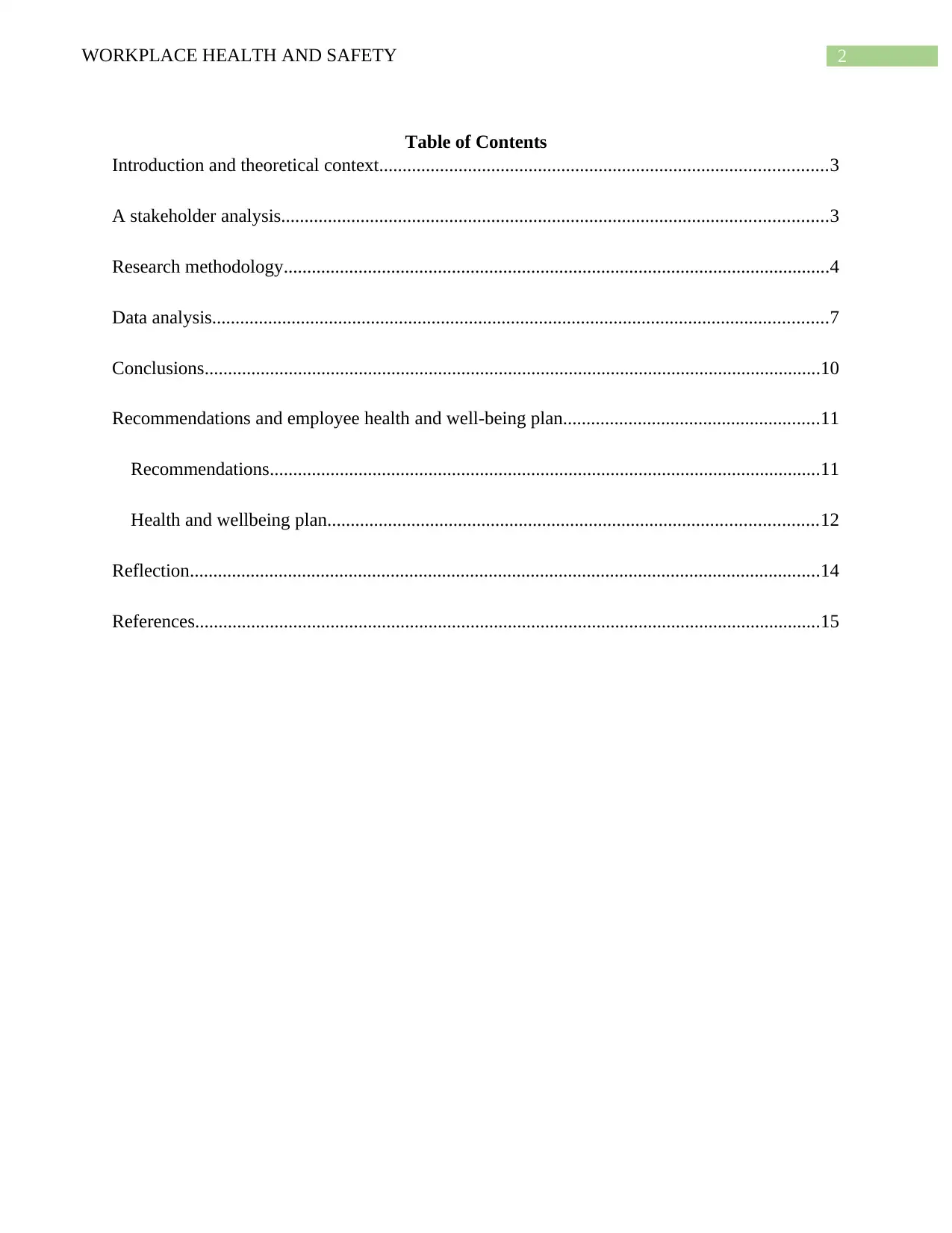
2WORKPLACE HEALTH AND SAFETY
Table of Contents
Introduction and theoretical context................................................................................................3
A stakeholder analysis.....................................................................................................................3
Research methodology.....................................................................................................................4
Data analysis....................................................................................................................................7
Conclusions....................................................................................................................................10
Recommendations and employee health and well-being plan.......................................................11
Recommendations......................................................................................................................11
Health and wellbeing plan.........................................................................................................12
Reflection.......................................................................................................................................14
References......................................................................................................................................15
Table of Contents
Introduction and theoretical context................................................................................................3
A stakeholder analysis.....................................................................................................................3
Research methodology.....................................................................................................................4
Data analysis....................................................................................................................................7
Conclusions....................................................................................................................................10
Recommendations and employee health and well-being plan.......................................................11
Recommendations......................................................................................................................11
Health and wellbeing plan.........................................................................................................12
Reflection.......................................................................................................................................14
References......................................................................................................................................15
⊘ This is a preview!⊘
Do you want full access?
Subscribe today to unlock all pages.

Trusted by 1+ million students worldwide
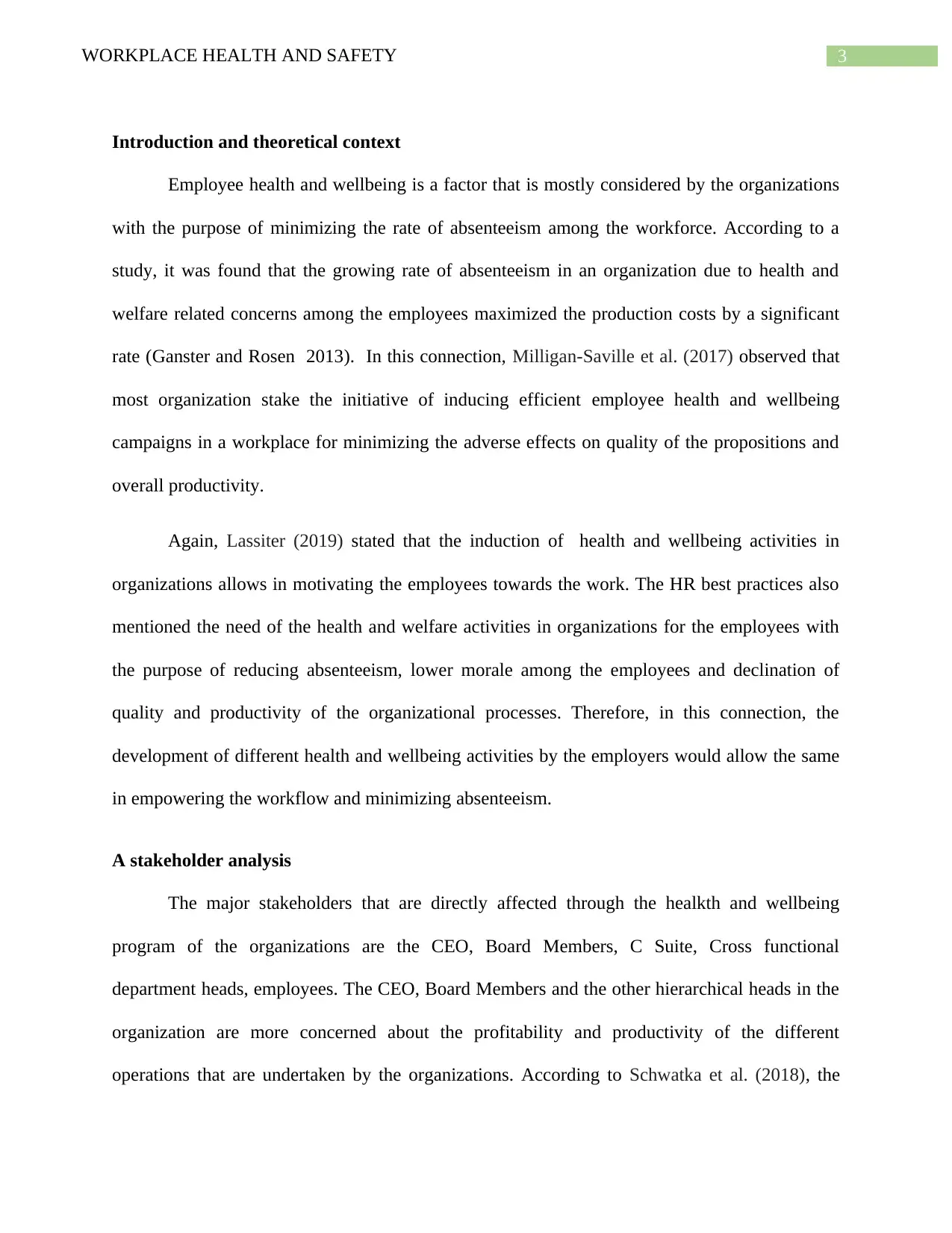
3WORKPLACE HEALTH AND SAFETY
Introduction and theoretical context
Employee health and wellbeing is a factor that is mostly considered by the organizations
with the purpose of minimizing the rate of absenteeism among the workforce. According to a
study, it was found that the growing rate of absenteeism in an organization due to health and
welfare related concerns among the employees maximized the production costs by a significant
rate (Ganster and Rosen 2013). In this connection, Milligan-Saville et al. (2017) observed that
most organization stake the initiative of inducing efficient employee health and wellbeing
campaigns in a workplace for minimizing the adverse effects on quality of the propositions and
overall productivity.
Again, Lassiter (2019) stated that the induction of health and wellbeing activities in
organizations allows in motivating the employees towards the work. The HR best practices also
mentioned the need of the health and welfare activities in organizations for the employees with
the purpose of reducing absenteeism, lower morale among the employees and declination of
quality and productivity of the organizational processes. Therefore, in this connection, the
development of different health and wellbeing activities by the employers would allow the same
in empowering the workflow and minimizing absenteeism.
A stakeholder analysis
The major stakeholders that are directly affected through the healkth and wellbeing
program of the organizations are the CEO, Board Members, C Suite, Cross functional
department heads, employees. The CEO, Board Members and the other hierarchical heads in the
organization are more concerned about the profitability and productivity of the different
operations that are undertaken by the organizations. According to Schwatka et al. (2018), the
Introduction and theoretical context
Employee health and wellbeing is a factor that is mostly considered by the organizations
with the purpose of minimizing the rate of absenteeism among the workforce. According to a
study, it was found that the growing rate of absenteeism in an organization due to health and
welfare related concerns among the employees maximized the production costs by a significant
rate (Ganster and Rosen 2013). In this connection, Milligan-Saville et al. (2017) observed that
most organization stake the initiative of inducing efficient employee health and wellbeing
campaigns in a workplace for minimizing the adverse effects on quality of the propositions and
overall productivity.
Again, Lassiter (2019) stated that the induction of health and wellbeing activities in
organizations allows in motivating the employees towards the work. The HR best practices also
mentioned the need of the health and welfare activities in organizations for the employees with
the purpose of reducing absenteeism, lower morale among the employees and declination of
quality and productivity of the organizational processes. Therefore, in this connection, the
development of different health and wellbeing activities by the employers would allow the same
in empowering the workflow and minimizing absenteeism.
A stakeholder analysis
The major stakeholders that are directly affected through the healkth and wellbeing
program of the organizations are the CEO, Board Members, C Suite, Cross functional
department heads, employees. The CEO, Board Members and the other hierarchical heads in the
organization are more concerned about the profitability and productivity of the different
operations that are undertaken by the organizations. According to Schwatka et al. (2018), the
Paraphrase This Document
Need a fresh take? Get an instant paraphrase of this document with our AI Paraphraser
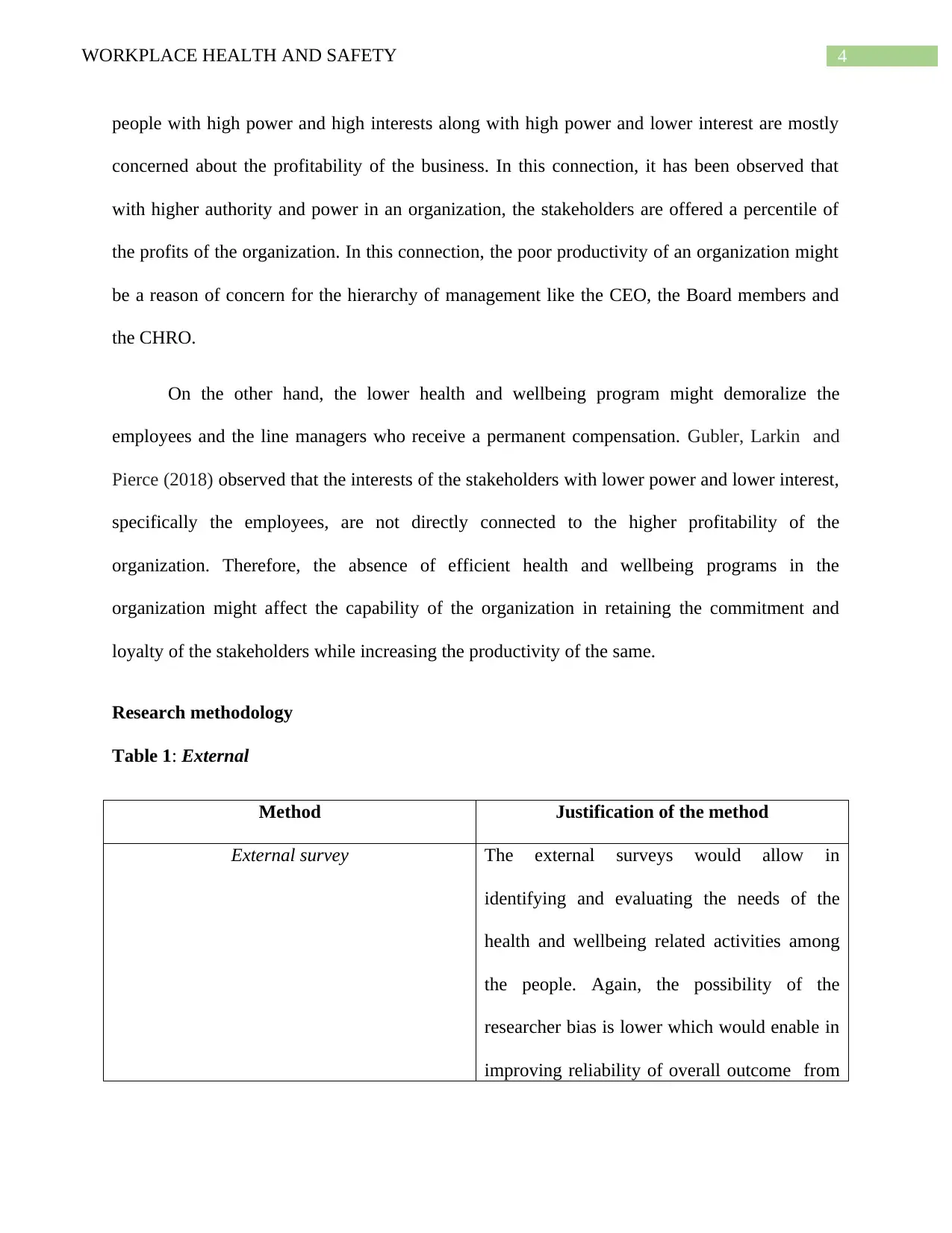
4WORKPLACE HEALTH AND SAFETY
people with high power and high interests along with high power and lower interest are mostly
concerned about the profitability of the business. In this connection, it has been observed that
with higher authority and power in an organization, the stakeholders are offered a percentile of
the profits of the organization. In this connection, the poor productivity of an organization might
be a reason of concern for the hierarchy of management like the CEO, the Board members and
the CHRO.
On the other hand, the lower health and wellbeing program might demoralize the
employees and the line managers who receive a permanent compensation. Gubler, Larkin and
Pierce (2018) observed that the interests of the stakeholders with lower power and lower interest,
specifically the employees, are not directly connected to the higher profitability of the
organization. Therefore, the absence of efficient health and wellbeing programs in the
organization might affect the capability of the organization in retaining the commitment and
loyalty of the stakeholders while increasing the productivity of the same.
Research methodology
Table 1: External
Method Justification of the method
External survey The external surveys would allow in
identifying and evaluating the needs of the
health and wellbeing related activities among
the people. Again, the possibility of the
researcher bias is lower which would enable in
improving reliability of overall outcome from
people with high power and high interests along with high power and lower interest are mostly
concerned about the profitability of the business. In this connection, it has been observed that
with higher authority and power in an organization, the stakeholders are offered a percentile of
the profits of the organization. In this connection, the poor productivity of an organization might
be a reason of concern for the hierarchy of management like the CEO, the Board members and
the CHRO.
On the other hand, the lower health and wellbeing program might demoralize the
employees and the line managers who receive a permanent compensation. Gubler, Larkin and
Pierce (2018) observed that the interests of the stakeholders with lower power and lower interest,
specifically the employees, are not directly connected to the higher profitability of the
organization. Therefore, the absence of efficient health and wellbeing programs in the
organization might affect the capability of the organization in retaining the commitment and
loyalty of the stakeholders while increasing the productivity of the same.
Research methodology
Table 1: External
Method Justification of the method
External survey The external surveys would allow in
identifying and evaluating the needs of the
health and wellbeing related activities among
the people. Again, the possibility of the
researcher bias is lower which would enable in
improving reliability of overall outcome from
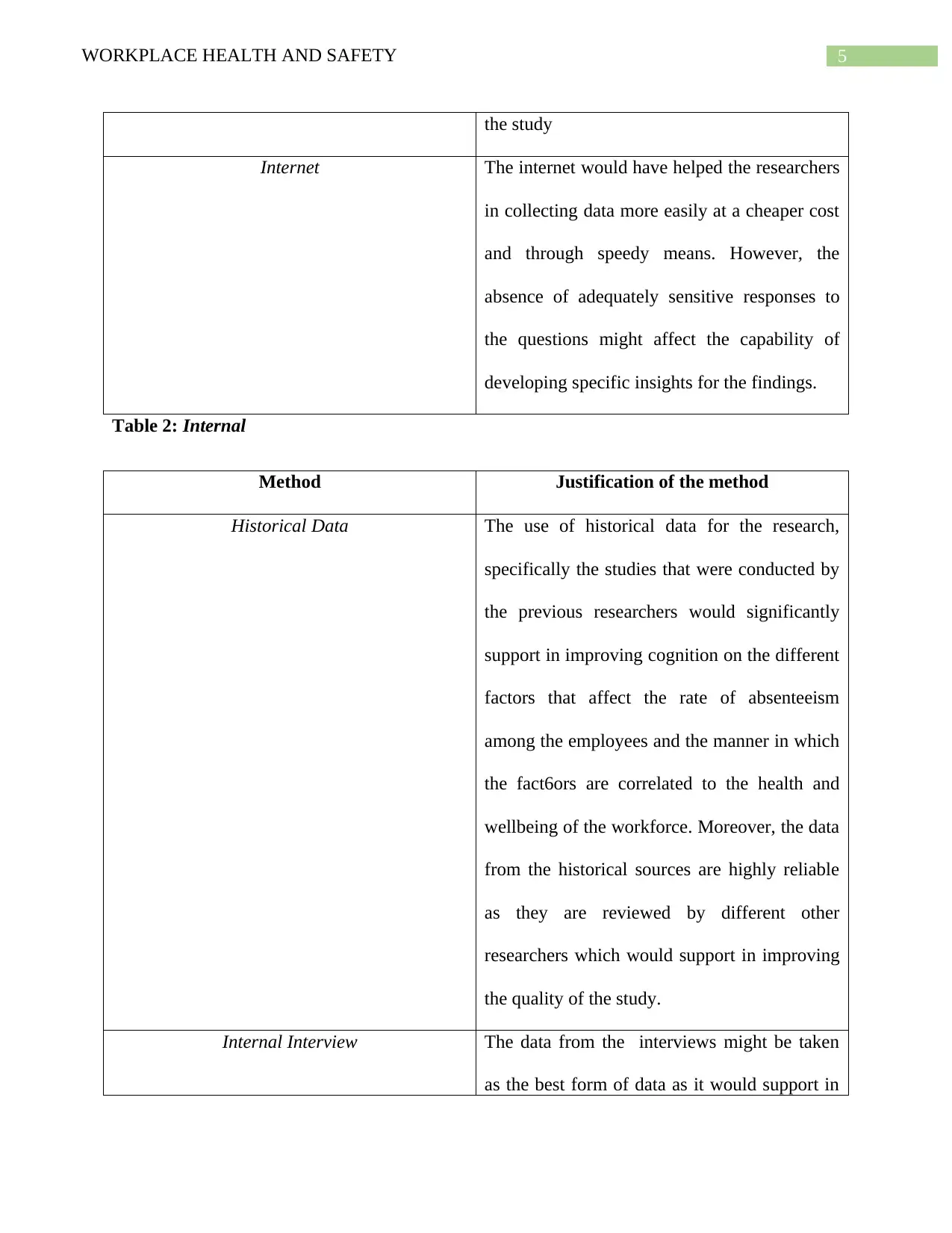
5WORKPLACE HEALTH AND SAFETY
the study
Internet The internet would have helped the researchers
in collecting data more easily at a cheaper cost
and through speedy means. However, the
absence of adequately sensitive responses to
the questions might affect the capability of
developing specific insights for the findings.
Table 2: Internal
Method Justification of the method
Historical Data The use of historical data for the research,
specifically the studies that were conducted by
the previous researchers would significantly
support in improving cognition on the different
factors that affect the rate of absenteeism
among the employees and the manner in which
the fact6ors are correlated to the health and
wellbeing of the workforce. Moreover, the data
from the historical sources are highly reliable
as they are reviewed by different other
researchers which would support in improving
the quality of the study.
Internal Interview The data from the interviews might be taken
as the best form of data as it would support in
the study
Internet The internet would have helped the researchers
in collecting data more easily at a cheaper cost
and through speedy means. However, the
absence of adequately sensitive responses to
the questions might affect the capability of
developing specific insights for the findings.
Table 2: Internal
Method Justification of the method
Historical Data The use of historical data for the research,
specifically the studies that were conducted by
the previous researchers would significantly
support in improving cognition on the different
factors that affect the rate of absenteeism
among the employees and the manner in which
the fact6ors are correlated to the health and
wellbeing of the workforce. Moreover, the data
from the historical sources are highly reliable
as they are reviewed by different other
researchers which would support in improving
the quality of the study.
Internal Interview The data from the interviews might be taken
as the best form of data as it would support in
⊘ This is a preview!⊘
Do you want full access?
Subscribe today to unlock all pages.

Trusted by 1+ million students worldwide
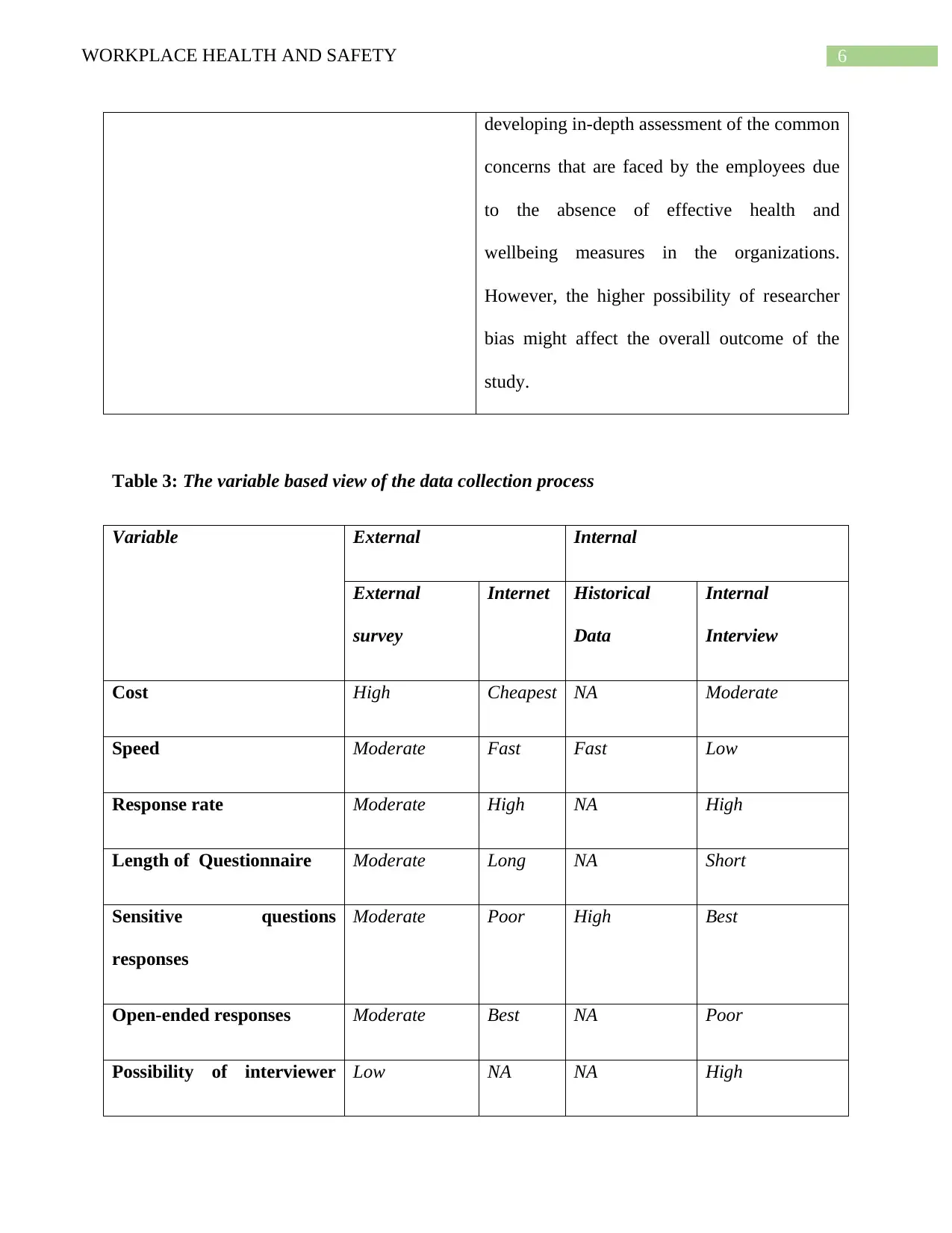
6WORKPLACE HEALTH AND SAFETY
developing in-depth assessment of the common
concerns that are faced by the employees due
to the absence of effective health and
wellbeing measures in the organizations.
However, the higher possibility of researcher
bias might affect the overall outcome of the
study.
Table 3: The variable based view of the data collection process
Variable External Internal
External
survey
Internet Historical
Data
Internal
Interview
Cost High Cheapest NA Moderate
Speed Moderate Fast Fast Low
Response rate Moderate High NA High
Length of Questionnaire Moderate Long NA Short
Sensitive questions
responses
Moderate Poor High Best
Open-ended responses Moderate Best NA Poor
Possibility of interviewer Low NA NA High
developing in-depth assessment of the common
concerns that are faced by the employees due
to the absence of effective health and
wellbeing measures in the organizations.
However, the higher possibility of researcher
bias might affect the overall outcome of the
study.
Table 3: The variable based view of the data collection process
Variable External Internal
External
survey
Internet Historical
Data
Internal
Interview
Cost High Cheapest NA Moderate
Speed Moderate Fast Fast Low
Response rate Moderate High NA High
Length of Questionnaire Moderate Long NA Short
Sensitive questions
responses
Moderate Poor High Best
Open-ended responses Moderate Best NA Poor
Possibility of interviewer Low NA NA High
Paraphrase This Document
Need a fresh take? Get an instant paraphrase of this document with our AI Paraphraser
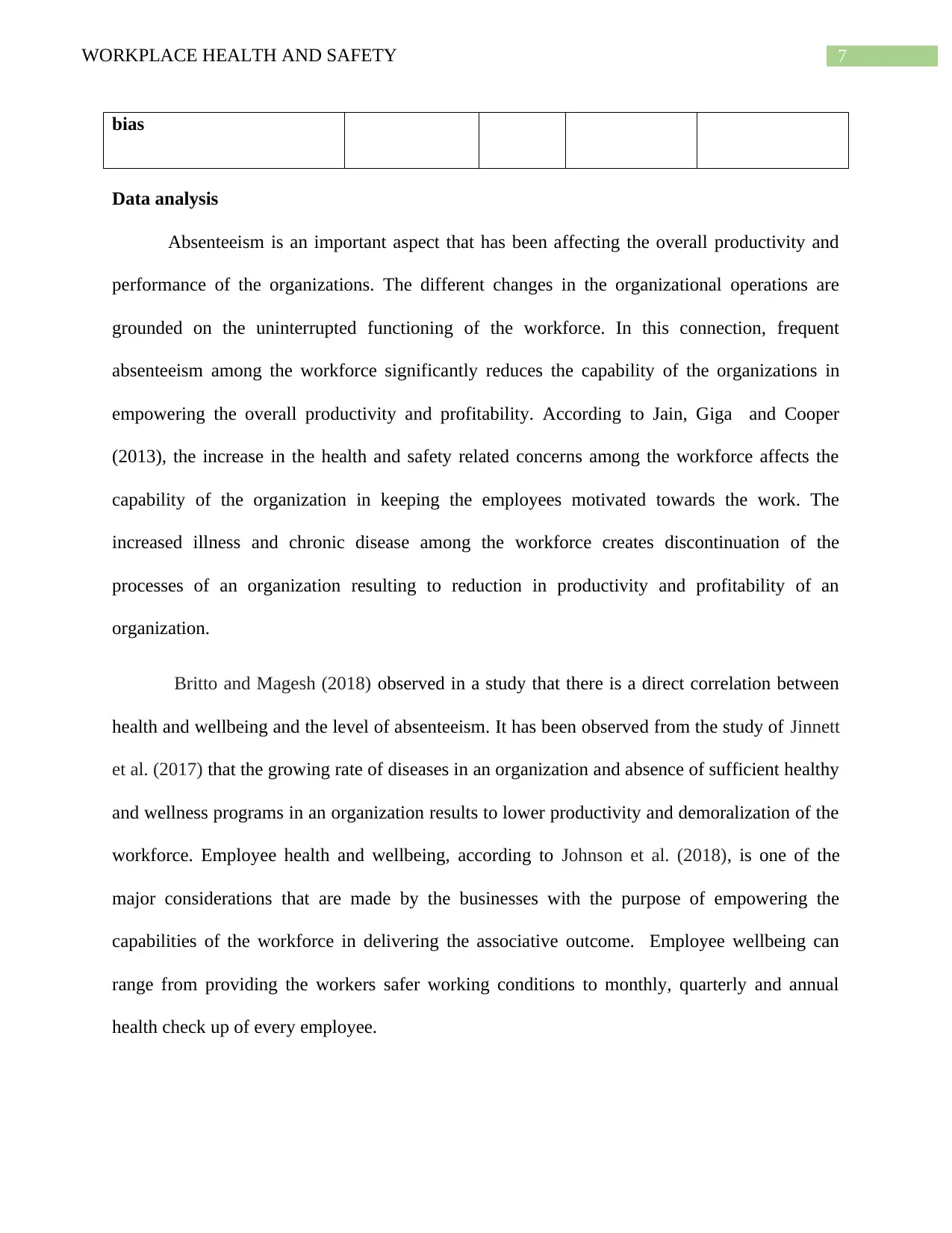
7WORKPLACE HEALTH AND SAFETY
bias
Data analysis
Absenteeism is an important aspect that has been affecting the overall productivity and
performance of the organizations. The different changes in the organizational operations are
grounded on the uninterrupted functioning of the workforce. In this connection, frequent
absenteeism among the workforce significantly reduces the capability of the organizations in
empowering the overall productivity and profitability. According to Jain, Giga and Cooper
(2013), the increase in the health and safety related concerns among the workforce affects the
capability of the organization in keeping the employees motivated towards the work. The
increased illness and chronic disease among the workforce creates discontinuation of the
processes of an organization resulting to reduction in productivity and profitability of an
organization.
Britto and Magesh (2018) observed in a study that there is a direct correlation between
health and wellbeing and the level of absenteeism. It has been observed from the study of Jinnett
et al. (2017) that the growing rate of diseases in an organization and absence of sufficient healthy
and wellness programs in an organization results to lower productivity and demoralization of the
workforce. Employee health and wellbeing, according to Johnson et al. (2018), is one of the
major considerations that are made by the businesses with the purpose of empowering the
capabilities of the workforce in delivering the associative outcome. Employee wellbeing can
range from providing the workers safer working conditions to monthly, quarterly and annual
health check up of every employee.
bias
Data analysis
Absenteeism is an important aspect that has been affecting the overall productivity and
performance of the organizations. The different changes in the organizational operations are
grounded on the uninterrupted functioning of the workforce. In this connection, frequent
absenteeism among the workforce significantly reduces the capability of the organizations in
empowering the overall productivity and profitability. According to Jain, Giga and Cooper
(2013), the increase in the health and safety related concerns among the workforce affects the
capability of the organization in keeping the employees motivated towards the work. The
increased illness and chronic disease among the workforce creates discontinuation of the
processes of an organization resulting to reduction in productivity and profitability of an
organization.
Britto and Magesh (2018) observed in a study that there is a direct correlation between
health and wellbeing and the level of absenteeism. It has been observed from the study of Jinnett
et al. (2017) that the growing rate of diseases in an organization and absence of sufficient healthy
and wellness programs in an organization results to lower productivity and demoralization of the
workforce. Employee health and wellbeing, according to Johnson et al. (2018), is one of the
major considerations that are made by the businesses with the purpose of empowering the
capabilities of the workforce in delivering the associative outcome. Employee wellbeing can
range from providing the workers safer working conditions to monthly, quarterly and annual
health check up of every employee.
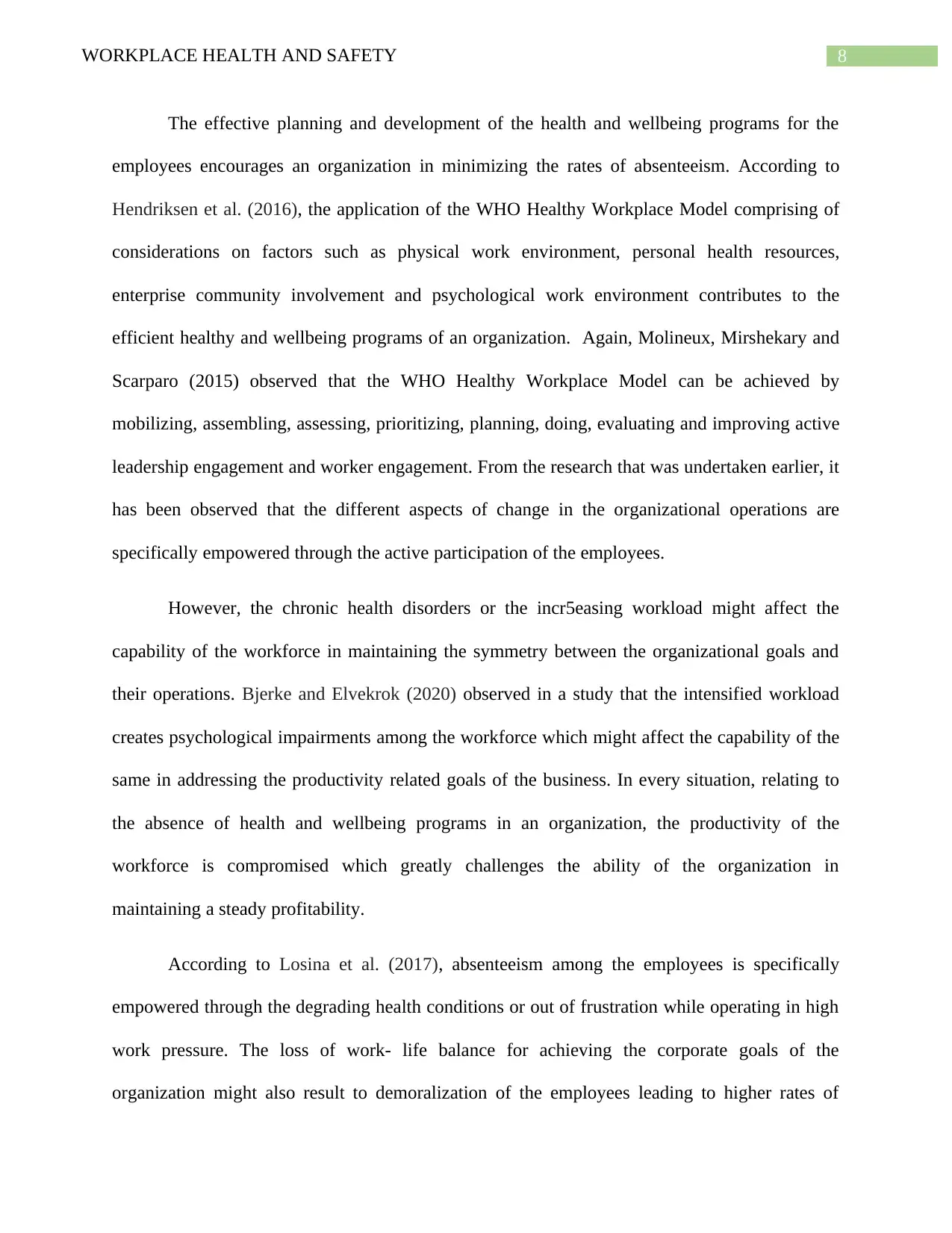
8WORKPLACE HEALTH AND SAFETY
The effective planning and development of the health and wellbeing programs for the
employees encourages an organization in minimizing the rates of absenteeism. According to
Hendriksen et al. (2016), the application of the WHO Healthy Workplace Model comprising of
considerations on factors such as physical work environment, personal health resources,
enterprise community involvement and psychological work environment contributes to the
efficient healthy and wellbeing programs of an organization. Again, Molineux, Mirshekary and
Scarparo (2015) observed that the WHO Healthy Workplace Model can be achieved by
mobilizing, assembling, assessing, prioritizing, planning, doing, evaluating and improving active
leadership engagement and worker engagement. From the research that was undertaken earlier, it
has been observed that the different aspects of change in the organizational operations are
specifically empowered through the active participation of the employees.
However, the chronic health disorders or the incr5easing workload might affect the
capability of the workforce in maintaining the symmetry between the organizational goals and
their operations. Bjerke and Elvekrok (2020) observed in a study that the intensified workload
creates psychological impairments among the workforce which might affect the capability of the
same in addressing the productivity related goals of the business. In every situation, relating to
the absence of health and wellbeing programs in an organization, the productivity of the
workforce is compromised which greatly challenges the ability of the organization in
maintaining a steady profitability.
According to Losina et al. (2017), absenteeism among the employees is specifically
empowered through the degrading health conditions or out of frustration while operating in high
work pressure. The loss of work- life balance for achieving the corporate goals of the
organization might also result to demoralization of the employees leading to higher rates of
The effective planning and development of the health and wellbeing programs for the
employees encourages an organization in minimizing the rates of absenteeism. According to
Hendriksen et al. (2016), the application of the WHO Healthy Workplace Model comprising of
considerations on factors such as physical work environment, personal health resources,
enterprise community involvement and psychological work environment contributes to the
efficient healthy and wellbeing programs of an organization. Again, Molineux, Mirshekary and
Scarparo (2015) observed that the WHO Healthy Workplace Model can be achieved by
mobilizing, assembling, assessing, prioritizing, planning, doing, evaluating and improving active
leadership engagement and worker engagement. From the research that was undertaken earlier, it
has been observed that the different aspects of change in the organizational operations are
specifically empowered through the active participation of the employees.
However, the chronic health disorders or the incr5easing workload might affect the
capability of the workforce in maintaining the symmetry between the organizational goals and
their operations. Bjerke and Elvekrok (2020) observed in a study that the intensified workload
creates psychological impairments among the workforce which might affect the capability of the
same in addressing the productivity related goals of the business. In every situation, relating to
the absence of health and wellbeing programs in an organization, the productivity of the
workforce is compromised which greatly challenges the ability of the organization in
maintaining a steady profitability.
According to Losina et al. (2017), absenteeism among the employees is specifically
empowered through the degrading health conditions or out of frustration while operating in high
work pressure. The loss of work- life balance for achieving the corporate goals of the
organization might also result to demoralization of the employees leading to higher rates of
⊘ This is a preview!⊘
Do you want full access?
Subscribe today to unlock all pages.

Trusted by 1+ million students worldwide
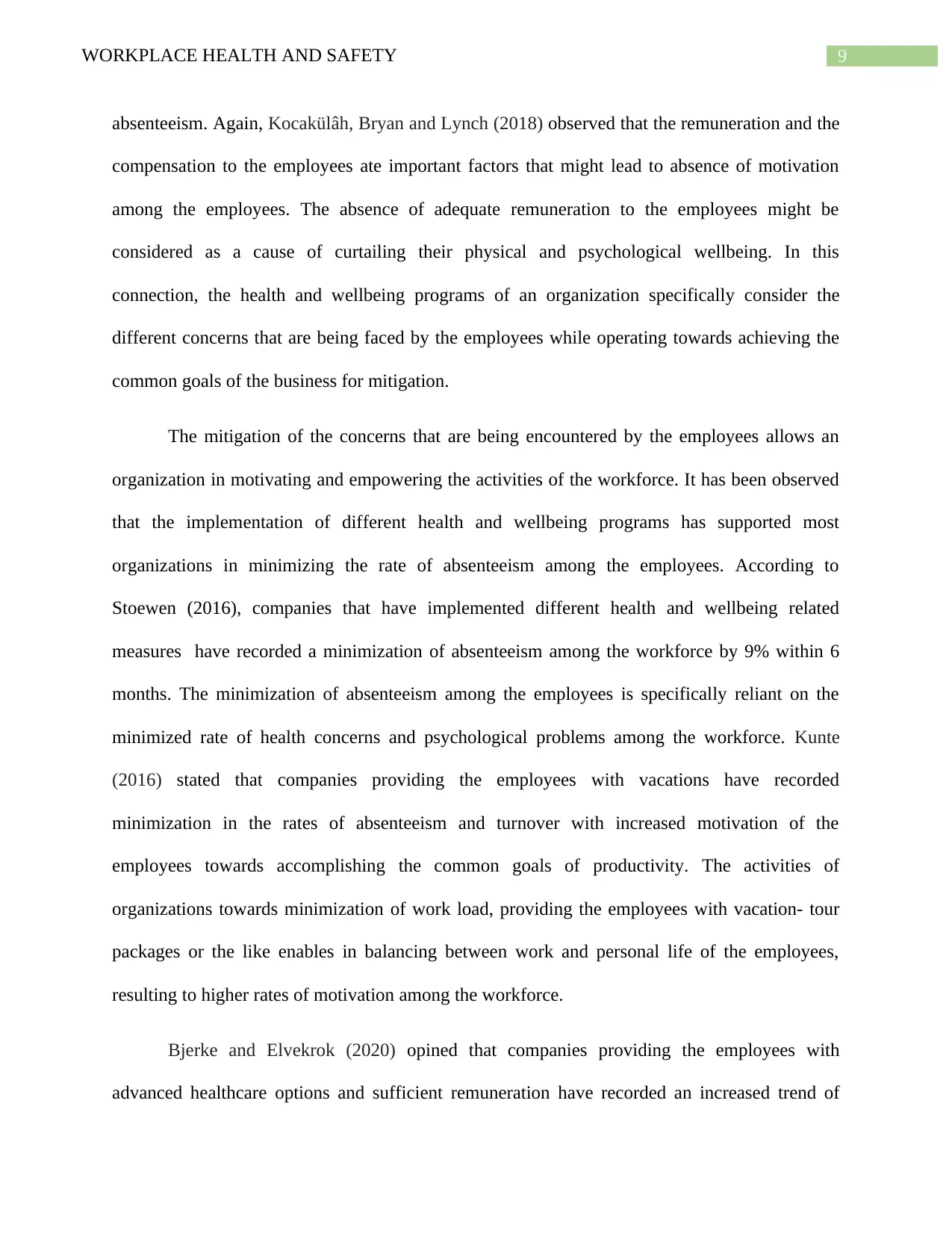
9WORKPLACE HEALTH AND SAFETY
absenteeism. Again, Kocakülâh, Bryan and Lynch (2018) observed that the remuneration and the
compensation to the employees ate important factors that might lead to absence of motivation
among the employees. The absence of adequate remuneration to the employees might be
considered as a cause of curtailing their physical and psychological wellbeing. In this
connection, the health and wellbeing programs of an organization specifically consider the
different concerns that are being faced by the employees while operating towards achieving the
common goals of the business for mitigation.
The mitigation of the concerns that are being encountered by the employees allows an
organization in motivating and empowering the activities of the workforce. It has been observed
that the implementation of different health and wellbeing programs has supported most
organizations in minimizing the rate of absenteeism among the employees. According to
Stoewen (2016), companies that have implemented different health and wellbeing related
measures have recorded a minimization of absenteeism among the workforce by 9% within 6
months. The minimization of absenteeism among the employees is specifically reliant on the
minimized rate of health concerns and psychological problems among the workforce. Kunte
(2016) stated that companies providing the employees with vacations have recorded
minimization in the rates of absenteeism and turnover with increased motivation of the
employees towards accomplishing the common goals of productivity. The activities of
organizations towards minimization of work load, providing the employees with vacation- tour
packages or the like enables in balancing between work and personal life of the employees,
resulting to higher rates of motivation among the workforce.
Bjerke and Elvekrok (2020) opined that companies providing the employees with
advanced healthcare options and sufficient remuneration have recorded an increased trend of
absenteeism. Again, Kocakülâh, Bryan and Lynch (2018) observed that the remuneration and the
compensation to the employees ate important factors that might lead to absence of motivation
among the employees. The absence of adequate remuneration to the employees might be
considered as a cause of curtailing their physical and psychological wellbeing. In this
connection, the health and wellbeing programs of an organization specifically consider the
different concerns that are being faced by the employees while operating towards achieving the
common goals of the business for mitigation.
The mitigation of the concerns that are being encountered by the employees allows an
organization in motivating and empowering the activities of the workforce. It has been observed
that the implementation of different health and wellbeing programs has supported most
organizations in minimizing the rate of absenteeism among the employees. According to
Stoewen (2016), companies that have implemented different health and wellbeing related
measures have recorded a minimization of absenteeism among the workforce by 9% within 6
months. The minimization of absenteeism among the employees is specifically reliant on the
minimized rate of health concerns and psychological problems among the workforce. Kunte
(2016) stated that companies providing the employees with vacations have recorded
minimization in the rates of absenteeism and turnover with increased motivation of the
employees towards accomplishing the common goals of productivity. The activities of
organizations towards minimization of work load, providing the employees with vacation- tour
packages or the like enables in balancing between work and personal life of the employees,
resulting to higher rates of motivation among the workforce.
Bjerke and Elvekrok (2020) opined that companies providing the employees with
advanced healthcare options and sufficient remuneration have recorded an increased trend of
Paraphrase This Document
Need a fresh take? Get an instant paraphrase of this document with our AI Paraphraser
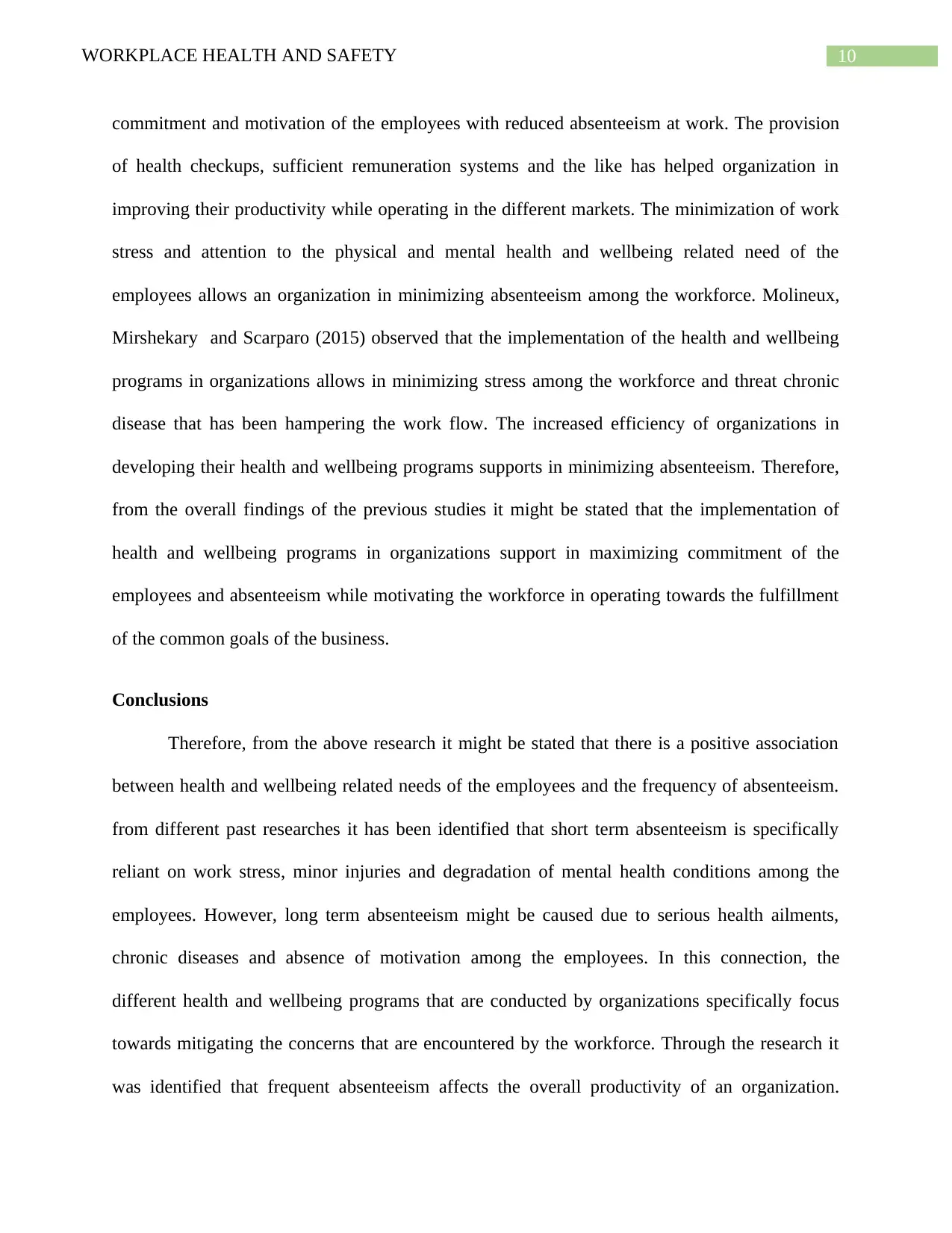
10WORKPLACE HEALTH AND SAFETY
commitment and motivation of the employees with reduced absenteeism at work. The provision
of health checkups, sufficient remuneration systems and the like has helped organization in
improving their productivity while operating in the different markets. The minimization of work
stress and attention to the physical and mental health and wellbeing related need of the
employees allows an organization in minimizing absenteeism among the workforce. Molineux,
Mirshekary and Scarparo (2015) observed that the implementation of the health and wellbeing
programs in organizations allows in minimizing stress among the workforce and threat chronic
disease that has been hampering the work flow. The increased efficiency of organizations in
developing their health and wellbeing programs supports in minimizing absenteeism. Therefore,
from the overall findings of the previous studies it might be stated that the implementation of
health and wellbeing programs in organizations support in maximizing commitment of the
employees and absenteeism while motivating the workforce in operating towards the fulfillment
of the common goals of the business.
Conclusions
Therefore, from the above research it might be stated that there is a positive association
between health and wellbeing related needs of the employees and the frequency of absenteeism.
from different past researches it has been identified that short term absenteeism is specifically
reliant on work stress, minor injuries and degradation of mental health conditions among the
employees. However, long term absenteeism might be caused due to serious health ailments,
chronic diseases and absence of motivation among the employees. In this connection, the
different health and wellbeing programs that are conducted by organizations specifically focus
towards mitigating the concerns that are encountered by the workforce. Through the research it
was identified that frequent absenteeism affects the overall productivity of an organization.
commitment and motivation of the employees with reduced absenteeism at work. The provision
of health checkups, sufficient remuneration systems and the like has helped organization in
improving their productivity while operating in the different markets. The minimization of work
stress and attention to the physical and mental health and wellbeing related need of the
employees allows an organization in minimizing absenteeism among the workforce. Molineux,
Mirshekary and Scarparo (2015) observed that the implementation of the health and wellbeing
programs in organizations allows in minimizing stress among the workforce and threat chronic
disease that has been hampering the work flow. The increased efficiency of organizations in
developing their health and wellbeing programs supports in minimizing absenteeism. Therefore,
from the overall findings of the previous studies it might be stated that the implementation of
health and wellbeing programs in organizations support in maximizing commitment of the
employees and absenteeism while motivating the workforce in operating towards the fulfillment
of the common goals of the business.
Conclusions
Therefore, from the above research it might be stated that there is a positive association
between health and wellbeing related needs of the employees and the frequency of absenteeism.
from different past researches it has been identified that short term absenteeism is specifically
reliant on work stress, minor injuries and degradation of mental health conditions among the
employees. However, long term absenteeism might be caused due to serious health ailments,
chronic diseases and absence of motivation among the employees. In this connection, the
different health and wellbeing programs that are conducted by organizations specifically focus
towards mitigating the concerns that are encountered by the workforce. Through the research it
was identified that frequent absenteeism affects the overall productivity of an organization.
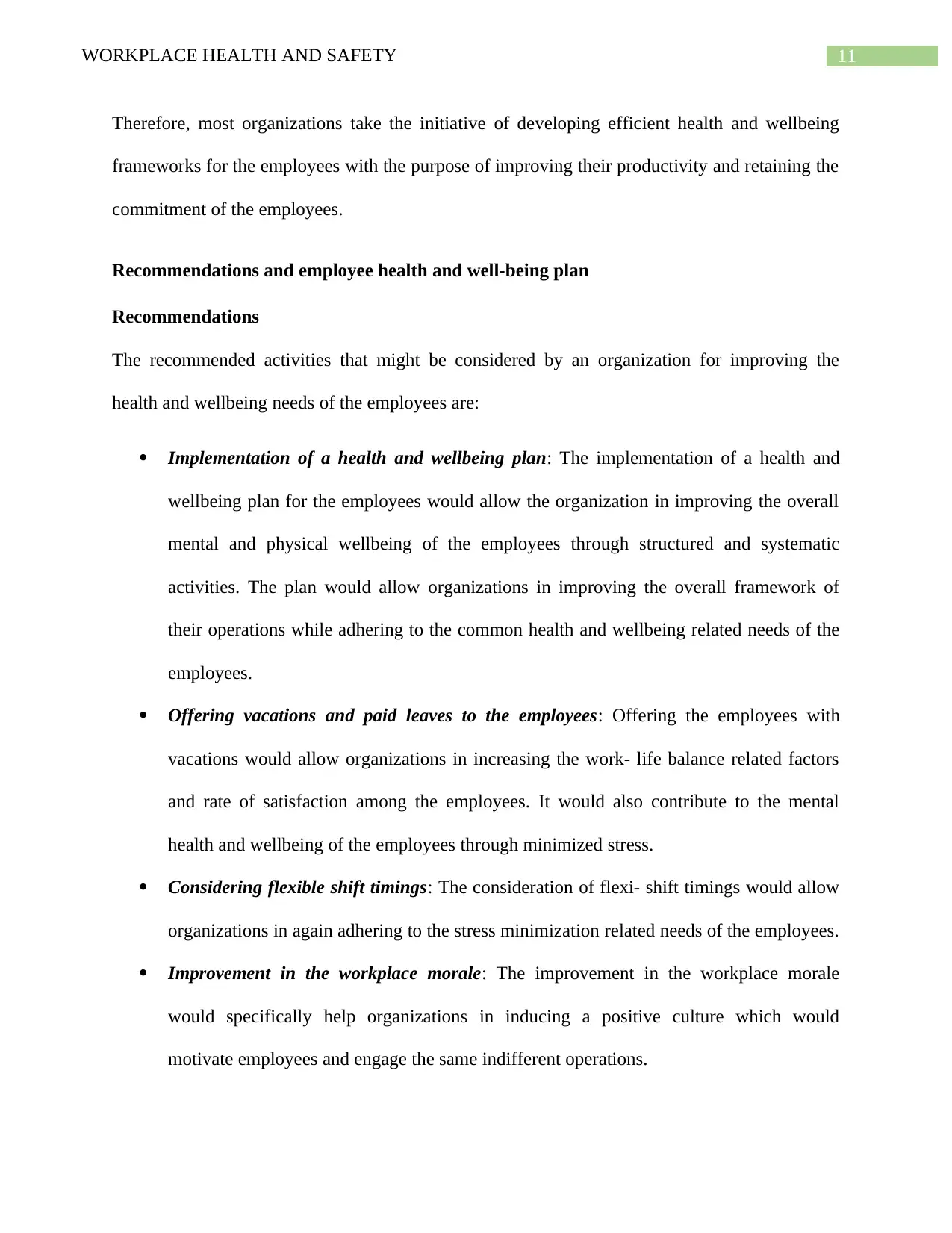
11WORKPLACE HEALTH AND SAFETY
Therefore, most organizations take the initiative of developing efficient health and wellbeing
frameworks for the employees with the purpose of improving their productivity and retaining the
commitment of the employees.
Recommendations and employee health and well-being plan
Recommendations
The recommended activities that might be considered by an organization for improving the
health and wellbeing needs of the employees are:
Implementation of a health and wellbeing plan: The implementation of a health and
wellbeing plan for the employees would allow the organization in improving the overall
mental and physical wellbeing of the employees through structured and systematic
activities. The plan would allow organizations in improving the overall framework of
their operations while adhering to the common health and wellbeing related needs of the
employees.
Offering vacations and paid leaves to the employees: Offering the employees with
vacations would allow organizations in increasing the work- life balance related factors
and rate of satisfaction among the employees. It would also contribute to the mental
health and wellbeing of the employees through minimized stress.
Considering flexible shift timings: The consideration of flexi- shift timings would allow
organizations in again adhering to the stress minimization related needs of the employees.
Improvement in the workplace morale: The improvement in the workplace morale
would specifically help organizations in inducing a positive culture which would
motivate employees and engage the same indifferent operations.
Therefore, most organizations take the initiative of developing efficient health and wellbeing
frameworks for the employees with the purpose of improving their productivity and retaining the
commitment of the employees.
Recommendations and employee health and well-being plan
Recommendations
The recommended activities that might be considered by an organization for improving the
health and wellbeing needs of the employees are:
Implementation of a health and wellbeing plan: The implementation of a health and
wellbeing plan for the employees would allow the organization in improving the overall
mental and physical wellbeing of the employees through structured and systematic
activities. The plan would allow organizations in improving the overall framework of
their operations while adhering to the common health and wellbeing related needs of the
employees.
Offering vacations and paid leaves to the employees: Offering the employees with
vacations would allow organizations in increasing the work- life balance related factors
and rate of satisfaction among the employees. It would also contribute to the mental
health and wellbeing of the employees through minimized stress.
Considering flexible shift timings: The consideration of flexi- shift timings would allow
organizations in again adhering to the stress minimization related needs of the employees.
Improvement in the workplace morale: The improvement in the workplace morale
would specifically help organizations in inducing a positive culture which would
motivate employees and engage the same indifferent operations.
⊘ This is a preview!⊘
Do you want full access?
Subscribe today to unlock all pages.

Trusted by 1+ million students worldwide
1 out of 19
Related Documents
Your All-in-One AI-Powered Toolkit for Academic Success.
+13062052269
info@desklib.com
Available 24*7 on WhatsApp / Email
![[object Object]](/_next/static/media/star-bottom.7253800d.svg)
Unlock your academic potential
Copyright © 2020–2025 A2Z Services. All Rights Reserved. Developed and managed by ZUCOL.





